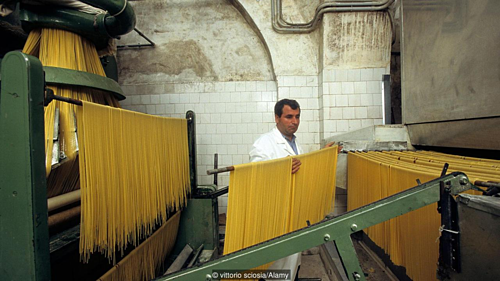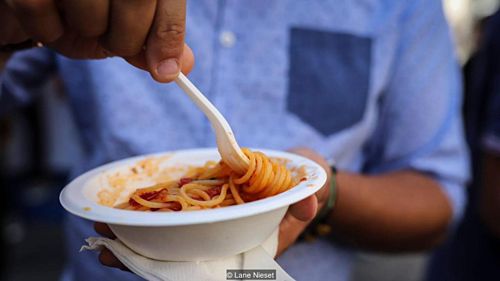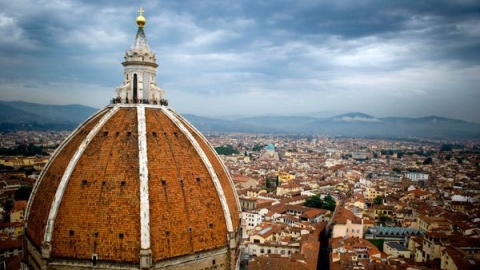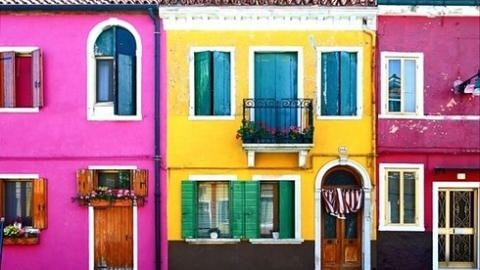Known as "Città della Pasta" (city of pasta), the coastal town of Gragnano became famous in the late 1700s for its "white gold," also known as pasta.
During its heyday, nearly 70% of Gragnano’s population made pasta, producing up to 100,000 kg of the product every day. When King Ferdinand II of Naples visited the city in the mid-1800s, he was so impressed that he chose Gragnano’s pasta factories as the official supplier to his summer palace at Quisisana, the former royal residence, located 5 km from Gragnano.

In the 19th century, Gragnano was a famous stop on the Grand Tour, a trip for wealthy Europeans. When European aristocrats wanted to prove that they had completed part of the Grand Tour, they would often bring pasta to say they had been to Gragnano.
Fresh pasta is a simple mix of flour, water, and eggs, more common in the regions of Piedmont, Lombardy, and Veneto. The dough is rolled to form tagliatelle (long, thin, flat pasta) or tortellini (ring-shaped, meat-stuffed pasta). Meanwhile, dry pasta requires just two ingredients: water and flour made from durum wheat. The dough is formed in traditional copper molds, which makes the pasta drier and more able to absorb sauce. In this town, dry pasta is preferred.
Gragnano is surrounded by mountains and sea, providing the ideal climate for drying pasta naturally. The buildings are staggered to allow a humid breeze to blow in several times a day. If you hadn’t seen the wheat flour flying into the air, you’d never guess that this quiet town was once one of the region’s biggest pasta producers.
"We can produce and dry pasta every day thanks to the prediction of the wind that blows through the village and into the valley," says Giuseppe Di Martino, who creates his pasta for Pastificio Di Martino, one of the three major pasta factories in Gragnano.

Pasta was traditionally dried on reeds. However, factories had to keep the streets clean, as they didn’t want the pasta to be contaminated with dust. The way Gragnano dried pasta was an art, refined over generations and a family secret. Since no preservatives or antibacterials existed at the time, pasta preservation depended on slow drying.
According to Di Martino, Gragnano was industrially redesigned to become a "pasta town", as factories exported large quantities of pasta to the United States.
In the early 1900s, Gragnano had nearly 120 pasta factories. However, the industrial boom replaced the open-air drying method, reducing the number of factories to 42. Factories increased in size but not in number. While they exported pasta to other markets, mechanical tools replaced human workers, increasing unemployment. This was the driving force behind many workers migrating to the United States in search of work.
When exports to the US were banned during World War I, Italians in America produced dry pasta with the help of machines. One thing they couldn’t replicate, however, was the taste. Gragnano’s pasta’s ingredients kept the flavor even after a six-week journey to America.
Nunzia Riccio, a food technologist and quality control manager, explains: "The water used to make pasta has lower mineral content than other regions, which doesn't change the taste. The wheat only takes three hours to travel from Puglia to Gragnano, so the dough is fresh and doesn't have time to develop mold or toxins."

Gragnano's first symbol was a sheaf of wheat, followed by a hand clutching the stalks like spaghetti. According to Di Massa, this symbol represents the relationship between the earth and manual labor.
Today, pasta is dried in closed production lines. But the air blowing into the engine is the same as that which once dried noodles hanging on the street.
As a way to pay homage to the city’s heritage, Gragnano’s pasta makers still cook and entertain people in the streets every September. It’s called the Festa della Pasta di Gragnano. The event was first held after World War II as a way to revive Gragnano’s traditional production. The festival typically attracts around 100,000 visitors over two days, with tens of thousands of plates of pasta sold each day. Celebrity chefs perform live cooking demonstrations right in the town center, where pasta once hung like curtains along the streets.

































